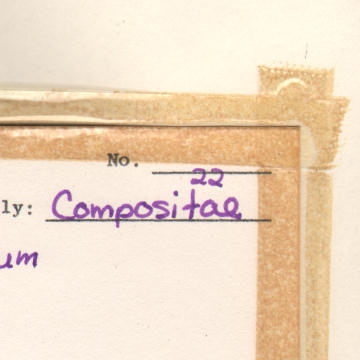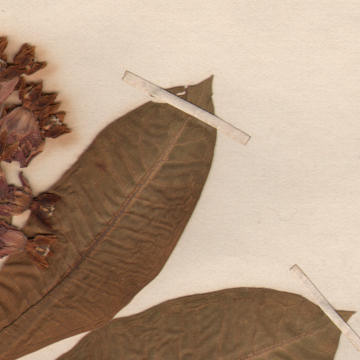I am in the process of digitizing and cataloging the vascular plant specimens housed in the herbarium at SUNY Cortland. Some of the specimens were not mounted properly or demonstrate other issues that may not have been obvious to the collector at the time. The purpose of this article is to describe a few of these issues and explain how to avoid them to improve the longevity of mounted plant specimens.
A standard herbarium sheet is 11.5 x 16.5 inches. Larger sized sheets do not fit properly into a folder and are prone to damage, and are also prone to damage other specimens as they jostle the other contents of the folder in which they are stored.
A 100% rag content sheet is optimal but 25-50% rag paper can be used. Of greatest importance is that it be acid-free. Not only will an acid paper deteriorate over time, but it will also damage any specimens that it comes into contact with. Below is an example of such a sheet that was damaged by a smaller sheet placed on top of it. You can see the damage as a darker rectangle in the lower left of the sheet.

Another problem with some of the specimens was the use of inappropriate mounting materials like scotch tape. The degree of deterioration varies. The plastic tape used to affix the label on the specimen below can be seen to have degraded badly and darkened the paper of both the herbarium sheet and label to a large extent.

If tape is to be used to help fix the specimen to the sheet it should be acid-free gummed linen tape. Some art suppliers carry this archival tape. Only thin strips are used and potentially the tape could be removed at a later date by re-softening the adhesive with water. The following image shows the tape used to mount a specimen that is now over 100 years old. As you can see it is still in excellent condition, however the paper on which it was mounted was not of the best quality so it has darkened quite a bit.

A final note regarding adhesives. The one most often used is polyvinyl acetate glue like “white glue” (Elmer’s). White glue is sensitive to heat and moisture and will degrade in UV light, but these should not be an issue in a properly maintained herbarium. I have found that when other, unknown adhesives had been used that they had turned brown, became brittle, and the specimen or label it was used to mount had fallen off. When using white glue it is usually diluted with a small amount of water (less than the amount of glue or it will be too thin), and dabbed gently onto the specimen with a paintbrush. After gluing the specimen and label onto the paper the entire sheet should be covered with wax paper and gently pressed and left to dry overnight. The latter step assures the best contact with the sheet and keeps the specimen and paper from curling as it all dries. Bulky specimens can be further reinforced with a little thread sown through the paper and around the stem. As evidenced by the plants in our collection a properly mounted a specimen will last for at least a century.
And don’t forget to include relevant information on the label. I have come across far too many specimens lacking dates and complete location information. Without these a specimen is largely useless for scientific study.